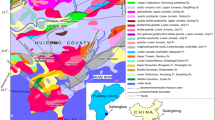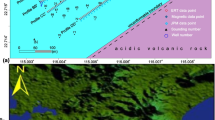Abstract
Subsurface geological formation is essential to validate design assumptions for the construction of deep engineering structures, especially in the weathered terrains. The geological formation can be delineated using resistivity values through an electrical survey. However, the subsurface resistivity alone is ambiguous to interpret the subsurface geological units. As part of an ongoing investigation to select the key methods towards this end, an integrated geophysical survey through a combination of electrical resistivity tomography (ERT), induced polarization (IP), magnetic method and joint profile method (JPM) was carried out in a weathered terrain of South Huizhou, China. Resistivity, IP, and magnetic data were obtained using a variety of survey parameters. Subsurface resistivity was calibrated with upfront boreholes lithology to constrain geological formation into four discrete layers such as topsoil cover with resistivity 2–3257 Ωm, highly weathered layer having resistivity 2–636 Ωm, partly weathered layer with resistivity range 448–1204 Ωm, and unweathered bedrock having resistivity 791–116,497 Ωm. The integration of ERT with IP, magnetic and JPM delineated four faults namely F1, F2, F3 and F4, and several localized fractures. The weathered layer, fractures and faults were marked as the weakest zones for engineering projects, whereas the unweathered fresh bedrocks were identified as the most appropriate locations for the construction of deep structures in the study area. The weakest zones unsuitable for engineering structures were delineated as the most appropriate places of groundwater occurrence in the studied area revealed by low resistivity ranging from 2 to 1204 Ωm and overlapped by low chargeability less than 14.8 ms. This non-invasive geophysical approach suggests the most suitable locations highly significant not only for the future construction of engineering structures but also the exploitation of groundwater resources in the investigated area.
Similar content being viewed by others
References
Akhter G, Hasan M (2016) Determination of aquifer parameters using geoelectrical sounding and pumping test data in Khanewal District. Pak Open Geosci 8(1):630–638
Asch TWJV, Hendriks MR, Hessel R, Rappange FE (1996) Hydrological triggering conditions of landslides in varved clays in the French alps. Eng Geol 42:239–251
Ayodele YG, Joshua AO, Sunday OJ (2015) An Engineering Site Characterization using Geophysical Methods: A Case Study from Akure, Southwestern Nigeria. J Earth Sci Geotech Eng 5(4):57–77
Beard LP, Hohmann GW, Tripp AC (1996) Fast resistivity/IP inversion using a low contrast approximation. Geophysics 61:169–179
Carbonel D, Gutiérrez F, Linares R, Roqué C, Zarroca M, McCalpin J, Guerrero J, Rodríguez V (2013) Differentiating between gravitational and tectonic faults by means of geomorphological mapping, trenching and geophysical surveys. The case of the Zenzano Fault (Iberian Chain, N Spain). Geomorphology 189(1):93–108. https://doi.org/10.1016/j.geomorph.2013.01.020
Cardarelli E, Cercato M, Cerreto A, Di Filippo G (2010) Electrical resistivity and seismic refraction tomography to detect buried cavities. Geophys Prospect 58:685–695
Chambers JE, Meldrum PI, Wilkinson PB, Ward W, Jackson C, Matthews B, Joel P, Kuras O, Bai L, Uhlemann S, Gunn D (2015) Spatial monitoring of groundwater drawdown and rebound associated with quarry dewatering using automated time-lapse electrical resistivity tomography and distribution guided clustering. Eng Geol 193:412–420. https://doi.org/10.1016/j.enggeo.2015.05.015
Dahlin T, Zhou B (2004) A numerical comparison of 2D resistivity imaging with 10 electrode arrays. Geophys Prospect 52:379–398
Dahlin T, Leroux V, Nissen J (2002) Measuring techniques in induced polarization imaging. J Appl Geophys 50(3):279–298. https://doi.org/10.1016/S0926-9851(02)00148-9
De Groot-Hedlin C, Constable SC (1990) Occam’s inversion to generate smooth, two-dimensional models from magnetotelluric data. Geophysics 55:1613–1624
Ellis RG, Oldenburg DW (1994) Applied geophysical inversion. Geophys J Int 116:5–11
Fan XM, Xu Q, Zhang ZY, Meng DS, Tang R (2009) The genetic mechanism of a translational landslide. Bull Eng Geol Env 68:231–244. https://doi.org/10.1007/s10064-009-0194-1
Gao Q, Shang Y, Hasan M, Jin W, Yang P (2018) Evaluation of a weathered rock aquifer using ERT method in South Guangdong, China. Water 10(3):293
García-Moreno I, Mateos RM (2011) Sinkholes related to discontinuous dumping: susceptibility zapping based on geophysical studies. The case of Crestatx (Majorca, Spain). Environ Earth Sci 64(2):523–537
Goldman M, Neubauer FM (2004) Groundwater exploration using integrated geophysical techniques. Surv Geophys 15(3):331–361
Griffiths DH, Barker RD (1993) Two-dimensional resistivity imaging and modeling in areas of complex geology. J Appl Geophys 29:211–226
Guangdong BGMR (Bureau of Geology and Mineral Resources of Guangdong Province) (1988) Regional geology of Guangdong Province. Geology Publishing House, Beijing, pp 1–602 (in Chinese)
Ha HS, Kim DS, Park IJ (2010) Application of electrical resistivity techniques to detect weak and fracture zones during underground construction. Environ Earth Sci 60:723–731
Hao JQ, Feng R, Zhou JG, Qian SQ, Gao JT (2002) Study on the mechanism of resistivity changes during rock cracking. Acta Geophysica Sinica 45(3):434–442
Hasan M, Shang Y, Akhter G, Khan M (2017a) Geophysical investigation of fresh-saline water interface: a case study from South Punjab, Pakistan. Groundwater 55:841–856
Hasan M, Shang Y, Akhter G, Jin W (2017b) Geophysical assessment of groundwater potential: a case study from Mian Channu Area. Pak Groundwater 56(5):783–796
Hasan M, Shang Y, Jin W (2018a) Delineation of weathered/fracture zones for aquifer potential using an integrated geophysical approach: a case study from South China. J Appl Geophys 157:47–60
Hasan M, Shang Y, Akhter G, Jin W (2018b) Evaluation of groundwater potential in Kabirwala area, Pakistan: a case study by using geophysical, geochemical and pump data. Geophys Prospect 66(9):1737–1750
Hasan M, Shang Y, Akhter G, Jin W (2018c) Delineation of saline-water intrusion using surface geoelectrical method in Jahanian Area. Pak Water 10:1548
Hasan M, Shang Y, Akhter G, Jin W (2019a) Application of VES and ERT for delineation of fresh-saline interface in alluvial aquifers of Lower Bari Doab, Pakistan. J Appl Geophys 164:200–213
Hasan M, Shang Y, Akhter G, Jin W (2019b) Delineation of contaminated aquifers using integrated geophysical methods in Northeast Punjab. Pak Environ Monitor Assess 192:12
Hongbin LV, Chengpeng L, Bill XH, Jiaxin R, Yanan Z, Qiang X, Juxiu T (2017) Characterizing groundwater flow in a translational rock landslide of southwestern China. Bull Eng Geol Env. https://doi.org/10.1007/s10064-018-1352-0
Ibitoye FP, Ipinmoroti FV, Salami M, Akinluwade KJ, Taiwo AT, Adetunji AR (2013) Application of geophysical methods to building foundation studies. Int J Geosci 4:1256–1266
Improta L, Ferranti L, De Martini PM, Piscitelli S, Bruno PP, Burrato P, Civico R, Giocoli A, Iorio M, D’Addezio G, Maschio L (2010) Detecting young, slow-slipping active faults by geologic and multidisciplinary high-resolution geophysical investigations: a case study from the Apennine seismic belt, Italy. J Geophys Res 115(B11307):1–26. https://doi.org/10.1029/2010JB000871
ABEM Instrument AB (2006) Terrameter SAS4000/SAS1000 LUND Imaging System, Instruction Manual
Jardani A, Revil A, Barrash WA, Crespy E, Rizzo S, Straface M, Cardiff B, Malama C, Miller C, Johnson T (2009) Reconstruction of the water table from self potential data: a Bayesian approach. Groundwater 47:213–227
Johnson TC, Versteeg RJ, Ward AF, Day-Lewis D, Revil A (2010) Improved hydrogeophysical characterization and monitoring through high performance electrical geophysical modeling and inversion. Geophysics 75(4):WA27–WA41. https://doi.org/10.1190/1.3475513
Jones MJ (1985) The weathered zones aquifers of basement complex area of Africa. Q J Eng Geol Lond 18:35–45
Kim JH, Yi MJ, Hwang SH, Song Y, Cho SJ, Synn JH (2007) Integrated geophysical surveys for the safety evaluation of a ground subsidence zone in a small city. J Geophys Eng 4:332–347
Krasny J (2002) Quantitative hardrock hydrogeology in a regional scale. Norges Geologiske Undersøkelse Bulletin 439:7–14
Kuria ZN, Woldai T, Van der Meer FD, Barongo JO (2010) Active fault segments as potential earthquake sources: inferences from integrated geophysical mapping of the Magadi fault system, southern Kenya Rift. J Afr Earth Sci 57:345–359
Li K, Shang Y, He W, Lin D, Hasan M, Wang K (2017) An engineering site suitability index (ESSI) for the evaluation of geological situations based on a multi-factor interaction matrix. Bull Eng Geol Env. https://doi.org/10.1007/s10064-017-1122-4
Loke MH (2007) Res2dinv Software User`s Manual, Version 3.57. Geotomo Software, Penang, Malysia, p 86
Loke MH, Barker RD (1996) Rapid least-squares inversion of apparent resistivity pseudosections by a quasi-Newton method. Geophys Prospect 44:131–152
Loke MH, Acworth I, Dahlin T (2003) A comparison of smooth and blocky inversion methods in 2D electrical imaging surveys. Explor Geophys 34(1):182–187
Loke MH, Chambers JE, Rucker DF, Kuras O, Wilkinson PB (2013) Recent developments in the direct-current geoelectrical imaging method. J Appl Geophys 95:135–156
Lucas DR, Fankhauser K, Springman SM (2016) Application of geotechnical and geophysical field measurements in an active alpine environment. Eng Geol 219:32–51
Revil A, Murugesu M, Prasad M, Le Breton M (2017) Alteration of volcanic rocks: a new non-intrusive indicator based on induced polarization measurements. J Volcanol Geoth Res 341:351–362. https://doi.org/10.1016/j.jvolgeores.2017.06.016
Routh PS, Oldenburg DW (2001) Electromagnetic coupling in frequency-domain induced polarization: a method for removal. Geophys J Int 145:59–76
Szalai S, Novak A, Szarka L (2011) Which geoeletric array sees the deepest in a noisy environment? Depth of detectability values of multielectrode systems for various two dimensional models. Phys Chem Earth 36(16):1398–1404
Tejero A, Chávez RE, Urbierta J, Flores- Márquez EL (2002) Cavity detection in the southwestern hilly portion of Mexico City by resistivity imaging. J Environ Eng Geophys 7:130–139
Ward SH (1990) Resistivity and induced polarization methods. In: Geotechnical and Environmental Geophysics. The Society of Exploration Geophysicists, 1991
Wyns RJC, Gourry JM, Baltassat, Lebert F (1999) Caractérisation multiparamètres des horizons de subsurface (0–100 m) en contexte de socle altéré. In: BRGM, IRD, UPMC, I. (ed.), 2ème Colloque GEOFCAN, Orléans, France. pp 105–110
Yuval, Oldenburg DW (1997) Computation of Cole-Cole parameters from IP data. Geophysics 62(2):436–448
Zhou W, Beck BF, Stephenson JB (1999) Reliability of dipole-dipole electrical resistivity tomography for defining depth to bedrock in covered karst terranes. Environ Geol 39(7):760–766
Acknowledgements
This research was conducted under a project by the Institute of Geology and Geophysics, Chinese Academy of Sciences, Beijing China; financially supported by Chinese Academy of Sciences for Post-doctoral fellowship (No. 2020PD01), National Basic Research Program of China (No. 2014CB046901), the Chinese National Scientific Foundation Committee (NSFC) (No. 41772320), and National Science and Technology Basic Resources Investigation Project (2018FY100503). Authors wish to acknowledge support received from Key Laboratory of Shale Gas and Geoengineering, Institute of Geology and Geophysics, Chinese Academy of Sciences, Beijing, China. We thank the anonymous reviewers and AE whose comments/suggestions helped improve and clarify this manuscript.
Author information
Authors and Affiliations
Corresponding authors
Additional information
Publisher's Note
Springer Nature remains neutral with regard to jurisdictional claims in published maps and institutional affiliations.
Rights and permissions
About this article
Cite this article
Hasan, M., Shang, Y., Jin, W. et al. An engineering site investigation using non-invasive geophysical approach. Environ Earth Sci 79, 265 (2020). https://doi.org/10.1007/s12665-020-09013-3
Received:
Accepted:
Published:
DOI: https://doi.org/10.1007/s12665-020-09013-3













